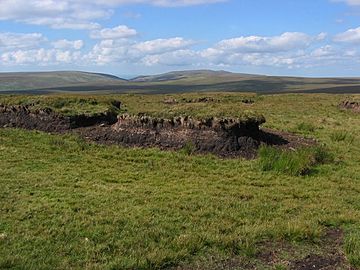Cut Hill facts for kids
Quick facts for kids Cut Hill |
|
|---|---|

Cut Hill
|
|
| Highest point | |
| Elevation | 603 m (1,978 ft) |
| Prominence | 90 m (300 ft) |
| Parent peak | High Willhays |
| Listing | Simm, Dewey, sub-HuMP, Tump |
| Geography | |
| Location | Devon, England |
| Parent range | Dartmoor |
| OS grid | SX598827 |
| Topo map | OS Landranger 191, Explorer 28N |
Cut Hill is a cool hill located in the northern part of Dartmoor. Dartmoor is a large area of moorland in the English county of Devon. Cut Hill stands tall at 603 metres (about 1,978 feet) above sea level. This makes it one of the highest points in Devon and on Dartmoor. It shares this spot with Hangingstone Hill, which is about 4 kilometres away.
Cut Hill is known for its amazing views. From the top, you can see some of the best scenery Dartmoor has to offer! But getting there can be a bit tricky. The ground around the hill is often wet and bumpy. There are also areas of deep peat, which are like spongy, muddy patches.
Where is Cut Hill?
Cut Hill is in a special part of Dartmoor. This area is used for military training. Because of this, you can only visit Cut Hill at certain times. It is one of the more remote spots on Dartmoor. It takes about an hour and a half to walk there from Postbridge.
How Cut Hill Got Its Name
The name "Cut Hill" comes from an old path called Cut Lane. This path was used long ago by "drovers." Drovers were people who moved large groups of farm animals, like cattle or sheep, across the moor. Cut Lane helped them guide their animals through the wet areas between the River Dart and River Tavy valleys.
Ancient Stone Row
In 2004, something very exciting was found at Cut Hill. Archaeologists discovered a stone row! This row of stones dates back to about 3,500 BC. That's a very long time ago, even before the famous Stonehenge.
The stone row at Cut Hill has nine granite stones. They are lined up in a northeast to southwest direction. This discovery was very important. Before this, there wasn't much proof of prehistoric life in this specific area. Dr. Tom Greeves, an archaeologist, said these stones are "of worldwide significance." This means they are important for understanding ancient history all over the world.

